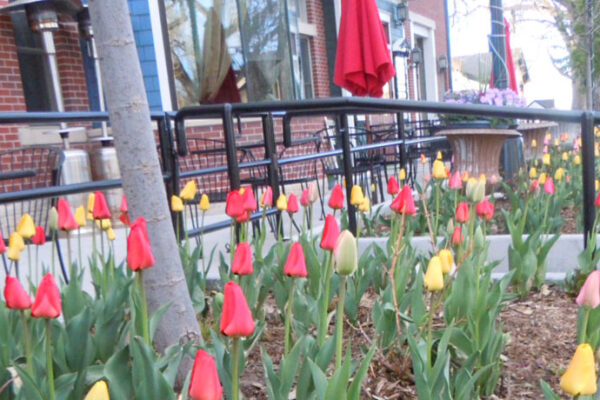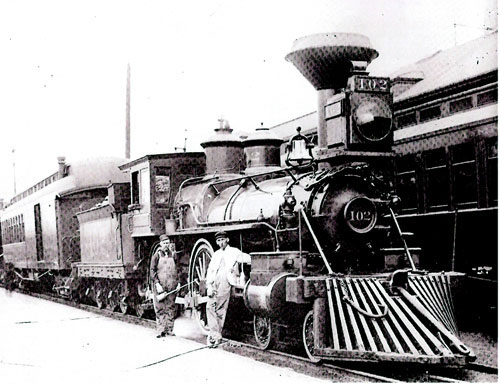
Historic Buildings and Photos Town of Parker CO
According to popular legend, Parker can trace its colorful history to the establishment of the Pine Grove Way Station by Alfred Butters, around 1863. Prior to that time, the area was used for hunting by Indians, say renowned archaeologists who have unearthed several semi-permanent hunting camps. The first residents of the area were the ancients (prehistoric) including Plains-Woodland Indians and later (1800s) mostly Arapahoe, Cheyenne
and Utes.
Railroads in Parker circa 1820
White men explored the general area in the early part of the nineteenth century: James Pursley in 1803, Baptiste LaLande in 1804, Stephen H. Long in 1820 and John Charles Fremont in 1843-44.
The old Indian trails that ran next to Cherry Creek near Parker were also used by early traders, trappers, frontiersmen and gold seekers, such as John Beck, Captain R.B. Marcy, William Green Russell, Thomas Fitzpatrick, Jim Baker, “Uncle Dick” Wootton, and Kit Carson.
The trail became known as the Cherokee Trail and a branch of Trapper’s Trail. When stage lines rolled into Colorado, it became known as the Smoky Hill Trail South, the West Cherry Creek Stage Road and the Denver-Santa Fe Stage Road.
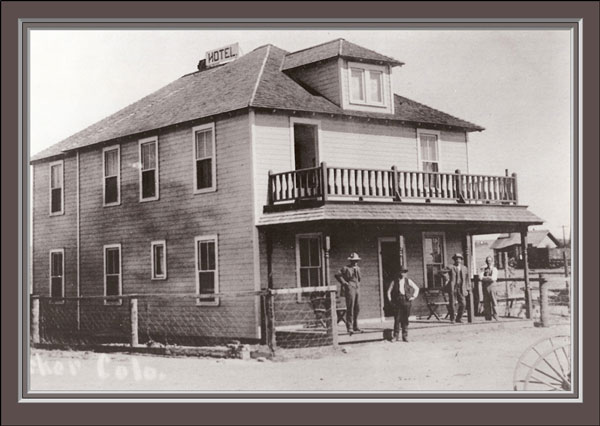
Rhode Island Hotel 1908.
This building now houses Fika Coffee House on Mainstreet.
Gold was discovered in Colorado in 1858, and the following year over 100,000 people followed the trails here in search of their fortunes. Small towns and settlements sprang up as the focus changed from gold to land.
Alfred Butters built a tiny one-room building in the pines just south of the Parker United Methodist Church around 1863. Butters handled mail, supplied provisions and a place to leave messages; it was a refuge for travelers and was appropriately named Pine Grove. He traded the building to a Mr. Goldsmith for a yoke of oxen and Goldsmith in turn sold to Mr. and Mrs. George Long in 1864.
To continue with the legend, the Longs moved the structure to its present location on Mainstreet, built an addition to include 10 rooms and a second story ballroom, and added some other buildings to accommodate animals and wagons.
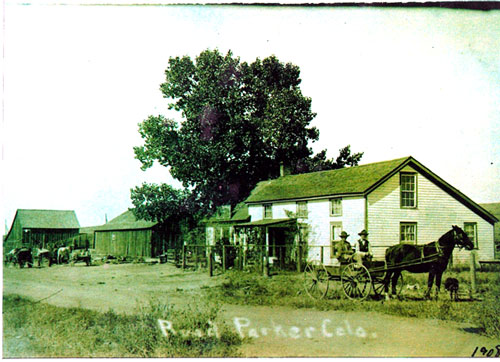
Since the structure was being situated about 20 miles from Denver City, the Longs named it 20-Mile House; it was a stage stop that provided meals, lodging and provisions. Although courthouse records bring the dates into question, historical accounts generally agree that George Long traded the 20-Mile House to Nelson and Susan Doud in 1869 for a span of mules. The legend says that the Douds sold it to James Sample Parker, an ex-bull-whacker and station manager who had been living in Kiowa, in 1874. The deed is dated September 15, 1870.
20 Mile House 1908 Parker Colorado
Under Parker’s ownership, the 20-Mile House grew and prospered; a blacksmith shop with equipment to shoe oxen and a general mercantile store were added to the facilities. It became Pine Grove’s first post office on December 8, 1870. James Parker granted rights-of-way for future roads, ditches, telephone lines and eventually the Denver & New Orleans Railroad. When his daughter, Edith Alice, reached school age, he provided the first schoolhouse across the road from the 20-Mile House. He also paid the teacher’s salary for the first year and provided her with room and board.
The town’s first cemetery was located atop the hill just east of the intersection of Highway 83 and E-470, but when Parker’s son Charlie died in 1874, his son Bela in 1882, and his first wife Mattie in 1887, he buried each on a knoll just northeast of 20-Mile House.
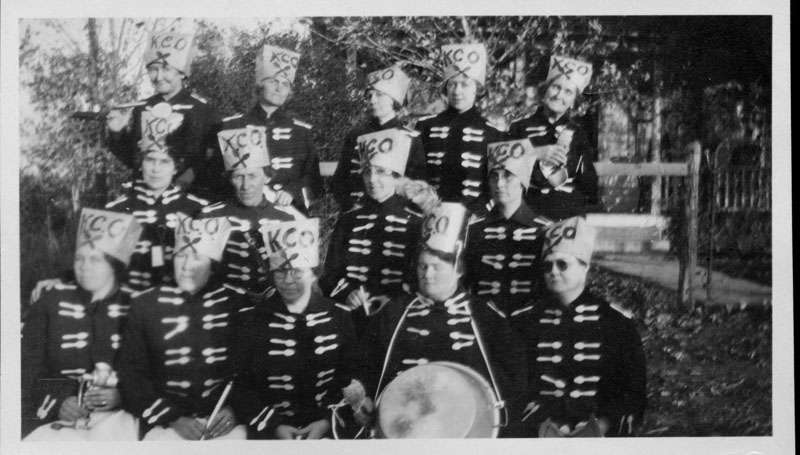
Those three plus acres were donated by James as the town’s new cemetery, and since it was surveyed in 1884, presumably that was when the land was donated, through to what organization is unknown. In 1885 the four people known to have been buried in the original cemetery were re-interred in the new one. Title to the cemetery was transferred by James Parker’s heirs to the J.S. Parker Cemetery Association in 1911.
Parker died in 1910 and was buried next to his wife Mattie. Nearby is the grave of another pioneer whose headstone reads “Jonathan Tallman. Killed by Indians, May 8, 1870.” Many of Parker’s first families are buried in this little cemetery.
Land west of Highway 83 was owned by James Parker, but the land east of the highway was homesteaded by James’ brother, George. George established a saloon and was instrumental in seeing that other businesses located in the growing town. The railroad provided the impetus and by the turn of the century Parker boasted a hotel, the post office, two blacksmith shops, water tower and pump house, three general mercantile, a dry goods store, a saloon, a livery stable, a brickworks, a stockyard, a creamery, a barber shop, a school, a few miscellaneous dwellings. And in nearby Newlin Gulch, gold was found in the mid-1880s.
Ave Maria Catholic Church 1860
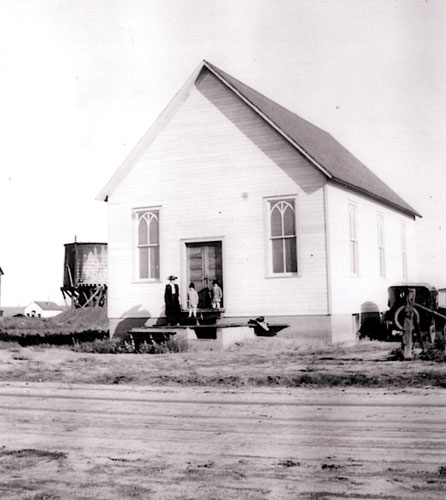
When you arrive in the town of Parker, what you’ll see amid the rolling plains is a growing community of new shops, low buildings, new home communities and lots of open space. Parker has worked hard to keep it’s small-town flavor and atmosphere even though it’s currently one of the fastest growing cities in the United States. You can find homes with an amazing view of the Rockies, Downtown City Lights, or nestled in the Pines.
Parker’s very modest beginning came in 1860, when a one-room shack was moved from Pine Grove over to Cherry Creek to serve as a stage stop called, appropriately, the Twenty-Mile House. It was twenty miles from the origination point of the Butterfield stage, what today is the intersection of Colorado Boulevard and Colfax Avenue in bustling Denver. The humble little shack grew into a ten-room Inn, changed hands twice and finally became a major stopping point for the railroad in 1882 under the ownership of James Sample Parker.
What doesn’t show when you’re in Parker today are the scars that ravaged the area during the 1930’s depression when the bank was robbed, railroad tracks were washed out and low produce prices almost wiped out the small village.
It was a struggle just to hang on for the next thirty years, but the same impetus that first created a need for the Twenty-Mile House provided the resuscitation the little town needed to become the hub of one of the fastest growing areas in the state today. That impetus was Denver.
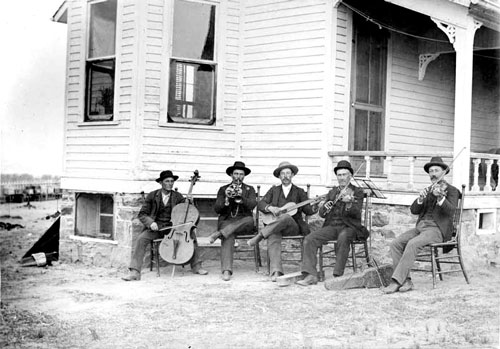
Denver, twenty miles to the northwest, was getting crowded. Developers and planners wisely looked to this area and found a beautiful environment where the rural living could combine with modern day necessities, where country pleasures would join with today’s desired amenities. Today, the Parker governmental agencies and residents are striving to ensure that this beautiful rural area is not spoiled by over-building and lack of planning. Beautiful walking and biking trails and equestrian facilities abound in the Parker vicinity.
Historic Franktown, located only seven miles south of Parker, was the original site of the Douglas County seat and the location of the first gold find in Colorado.
Source: Parker Area Historical Society
Photo Source: Parker Historical Society Douglas County Library
For those who desire acreage or stable facilities, the Parker area and Douglas County abound with a variety of choices. While driving around the Parker area, one might imagine they are in Kentucky with all the beautiful rolling green hills, rail fences, horses, stables, arenas and barns in the area. Pick-up trucks and large horse trailers are a familiar sight on Douglas County roads.
Parker Consolidated Schoolhouse Restoration Project
The Parker Consolidated Schoolhouse became a century old in 2015. For decades, The Schoolhouse served as the area’s only K-12 school. In recent years, it has been known as the Mainstreet Center and served as downtown Parker’s educational and cultural center. To honor the building’s heritage, the Town of Parker has rebranded the structure as “The Schoolhouse.”
The Town was awarded two grants from the Colorado State Historical Fund to support restoration work on The Schoolhouse with the Phase I grant being $100,275 and Phase II being $198,045. The first phase of construction, with a price tag of $213,975, restored the Mainstreet-facing windows and entrance. In addition, the principal’s office above the main entrance, added in the 1950s, was removed which opened up the entrance restoring it to its original impressive appearance.
Phase II construction, at a cost of $849,218, was completed in late fall 2016. It included replacement of the outdated and inefficient heating system with two hydronic boilers; creation of an enlarged dance studio in the lower level; the addition of an elevator shaft; window rehab; and exposing and restoring the beautiful wood trim and flooring throughout the lower level.
More recently, the Town was awarded a third $200,000 grant for Phase III work. This final phase is slated to begin later this winter with completion planned for early fall 2017. The project will include restoring the first floor and converting it into a flexible gallery/event space; an elevator addition; exterior brick restoration; a new roof; and restoration of the rooftop cupola. Contract price negotiations are underway with the contractor for this final phase.
Town of Parker History
A Brief History
- April 1992: The Parker Cultural Commission is formed and community events are offered. Initial events include Concerts in the Park and Images of Parker Art Show.
- Dec. 1995: The Town of Parker purchases the Mainstreet Center to house cultural and recreation programs and to preserve an important historic building.
- 2001-2002: Study is conducted on the potential expansion/renovation of the Mainstreet Center into a modern performance facility. The council declines to explore further at that time due to cost.
- 2004-2005: Meetings occur between the Town of Parker, Douglas County Libraries and Douglas County School District on a possible partnership for an arts center. The groups jointly commission a study on a partnership for property to the west of Parker’s Town Hall.
- March-June 2006: The Town purchases land west of Town Hall in two parcels for the future development of an arts center, library and retail shops.
- 2006-2007: Representatives from the Town of Parker and Douglas County Libraries meet regularly to discuss planning and funding. The School District declines further involvement. The Town and Library create a Cultural Authority for joint planning for the site and explore options for funding the construction.
- March 2007: The Parker Cultural Arts Center business plan is prepared for the Town by Webb Management Services.
- Aug. 2007: An architectural competition is held by the Cultural Authority. Semple Brown Design and Humphries Poli Design teams are selected.
- Nov. 2007: The Library puts the funding issue for the new library on the ballot. It does not pass.
- Jan. 2008: The Town decides not to place the arts center item on the ballot as previously planned, after the library failure. Parker Town Council considers alternative funding options for an arts center.
- July 2008: The Council authorizes proceeding with the design of the arts center project from existing funds and plans for a $21.7 million construction budget through the issuance of certificates of participation. The Library puts the new library issue on Nov. 2008 ballot.
- Nov. 2008: The second library ballot issue for funding fails.
- Nov. 2008: The Greater Parker Foundation is incorporated. This nonprofit serves as an umbrella for fundraising for the Parker Arts, Culture and Events (PACE) Center, as well as other projects.
- July 2009: The Council approves the certificate of participation transaction to jointly fund the PACE Center and a new police station in Parker.
- April 2010: Groundbreaking takes place for the PACE Center.
- Fall 2011: PACE Center opens! Read about the PACE Center history here


